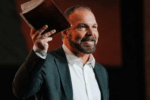Why we’re connecting people more than ever in 2012—and why that matters to you
A year after God brought the Israelites out of Egypt, He instructed Moses to take a census of the entire Jewish community. Though the newly liberated people were certainly growing in number, the point of this head count was as much about identity as it was about statistics.
By identifying the 12 tribes (along with a “13th tribe,” the Levites), numbering them and placing them in order, God established each family’s unique role and function as part of a larger community. And because these tribes were connected by blood to one another—through their leaders, the sons of Jacob (Israel)—God was also instilling in every Israelite a sense of both individual and corporate identity. They would have to wait another 39 years for a physical land, but the Israelites were already in the process of becoming a nation, and this began with each person understanding his or her place in a community that was destined to fulfill a bigger purpose.
We in the Spirit-filled community would do well to embark on the same process. Indeed, many of us need an identity reminder—not necessarily individually, but in knowing the bigger part we play within the body of Christ. Despite holistically making up the largest and fasting-growing segment of evangelical Christendom, charismatics often tend to become isolated “tribes.” Yet it’s key that we have a clear vision of how our individual communities fit into God’s bigger picture of the charismatic community at large—and beyond that, the global church. We gain this broader scope in part by being informed about what else is going on in the larger community, and by connecting with other tribes.
For more than 36 years, that’s exactly what Charisma has been doing in its unique role as a connective hub for the Spirit-filled community. Despite ongoing shifts in our movement, we serve as one of the lone common denominators among an extremely varied, often polarized audience representing multiple charismatic tribes. Many of these groups have wonderful things happening in their own circles as the Holy Spirit continues to move in power. But many are also clueless about how God is using the charismatic community next door and how they can support or further that move.
That’s a tragedy, and it’s part of the reason Charisma has launched an initiative in 2012 called “The 12 Communities of Charisma” to reconnect the major groups that comprise our readership. We’re not out to conform these tribes that we love; after all, like the tribes of Israel, we’re family—and family comes in all shapes, sizes and even theological beliefs. But we do want to help each community be more aware of how God is moving in other groups and, equally as important, better connect them to one another for the sake of serving the global church.
So here’s who we have identified as the 12 major communities that make up Charisma, in no particular order:
1) Core Charismatics/Independent Charismatics. Comprising more than 40 percent of Charisma’s readership, these believers are often part of churches or ministries linked to smaller networks. They’re passionate about seeing the fruit and gifts of the Holy Spirit operating in their lives, and most serve in some form of leadership at a healthy, thriving charismatic church. Gateway Church (Dallas), Bethany World Prayer Center (Baton Rouge, La.) and New Life Church (Colorado Springs, Colo.) are all prime examples of churches in this tribe.
2) Classical Pentecostals. More than a quarter of our readers come from a traditional Pentecostal community such as the Church of God or Foursquare denominations. Yet by far the largest segment of this tribe are those from the Assemblies of God—now the largest Protestant denomination in the world with more than 64 million adherents.
3) African-American Charismatics/Pentecostals. For decades, one of Charisma’s key functions has been as a bridge-builder between races. Our partnerships with denominations such as the Church of God in Christ prove that we continue to be a catalyst for unity while breaking down church racial walls.
4) Relative Charismatics & Spirit-Sensitive Evangelicals. Most Christians don’t realize that the overwhelming majority of the fastest-growing churches in the United States are charismatic/Pentecostal. Among those, several are what we describe as “relative charismatic”—those without overt charismatic connections in name, messaging or marketing, but that believe in the baptism of the Holy Spirit and regularly convey charismatic theology. Leaders such as Greg Surratt (SeaCoast Church) and Mark Batterson (National Community Church) have all contributed to Charisma over the years, as have “Spirit-Sensitive Evangelicals” such as Francis Chan, Louie Giglio, Rick Warren and Beth Moore.

6) Messianic/Zionist Movement. As the global number of Messianic Jews has grown to an estimated 75,000 to 100,000, Charisma has continued to report on and stand with this unique tribe of believers. And because our readers are deeply passionate about all things Israel, we’ll further that coverage this year.
7) Denominational Charismatics. Among this group, which accounts for almost 15 percent of our readership, most can point to a time past when the Holy Spirit moved powerfully through their individual denomination—whether the Catholic Charismatic renewal, or the Lutheran or Methodist movements. In 2012, we’ll delve deeper into what the Spirit is now doing in these varied denominations, including the massive shift among Southern Baptists open to charismatic theology.
8) Apostolic/Prophetic Movement. This community includes prophetically gifted leaders, those placing a renewed emphasis on the role of the apostle and an intercessory/spiritual warfare sub-movement. Members are often active in other communities as well and tend to align theologically with ministry leaders such as Cindy Jacobs, Peter Wagner and Mike Bickle.
9) Word-Faith Movement. Led by high-profile ministers such as Kenneth Copeland and Creflo Dollar, today’s Word-Faith movement is still a tightly connected community held together by an emphasis on the confession and proclamation of God’s Word. Among Charisma’s readership, those who consider themselves Word-Faith are often the most likely to connect with and give toward large television ministries.
10) House Church Movement. Though a fragment of our readership, house churches are drastically changing the church at large through a renewed emphasis on raw, relational gatherings among believers. Leaders such as Tony and Felicity Dale and Larry Kreider have not only been adhering to this model for years, they’ve also done it as overtly charismatic believers.
11) Revivalist Movement. From Toronto to Brownsville to the Bethel (Redding, Calif.) revival, the charismatic renewal has always been a magnet for believers who are hungry to see God move through signs and wonders. Today’s revivalists include the likes of Rodney Howard-Browne, Bill Johnson and Randy Clark and typically maintain a uniquely global worldview.
12) Hispanic & Minority Charismatics/Pentecostals. Though many in the Spirit-filled Hispanic community would opt for our sister publication, Vida Cristiana, the Latino church—combined with the ever-growing immigrant church—reflects the shifting culture of the entire American charismatic movement. As more developing nations become open to the gospel, we believe many of the Spirit-filled church’s leading voices will emerge from this multi-ethnic tribe.
Last month we subtly began this initiative of reconnecting the 12 communities of Charisma through J. Lee Grady’s “12 Spiritual Trends to Watch in 2012” and our emphasis on Messianic rabbi Jonathan Cahn. This issue, you’ll notice a more pronounced approach to spotlighting February’s “community of the month,” the classical Pentecostals. Along with sharing the remarkable mission of Pentecostal leader Jeff Farmer (p. 36), we asked charismatic historian Vinson Synan to assess where the classical Pentecostal community has been and where it’s headed (p. 42).
You can expect more than just insight and information in 2012 as we celebrate the 12 communities of Charisma. I pray our efforts to connect the varied tribes that we comprise will, as was the case with Israel, spur us all to a renewed sense of identity in the body of Christ.
Marcus Yoars is the editor of Charisma. You can connect with him on Twitter @marcusyoars or facebook.com/marcusyoars.







Leave a Comment
You must be logged in to post a comment.